Blog
Archives
.
. . from 2012 to current
. .
THURSDAY
APRIL 23 - 2015
Slipper
Millpond
The female
Great Black-backed Gull was sitting on the nest
on the centre raft of Slipper Millpond when I passed
by this morning. It is clearly settled and sitting on
eggs. As can be seen from the photo the nest is right
on the edge of the raft which still has its wires
which the residents erected as a deterrent.
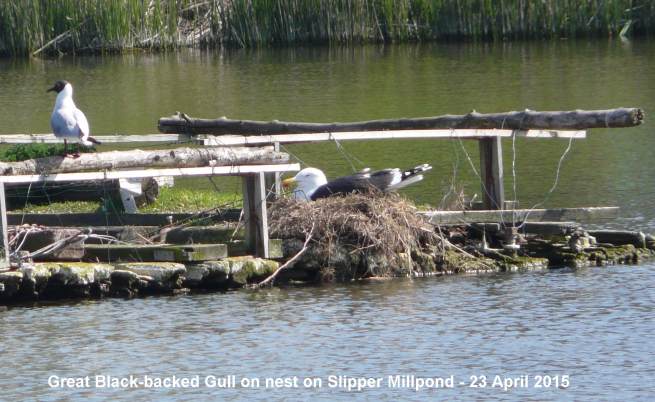
The Coot family
has lost another chick since yesterday and is now
down to two. I suspect these two will be picked off by
the large gulls over the next few days.
The very attractive pink flowers are now out on the
Tree Mallow plants around the pond.

Nightingale
at Marlpit Lane
Terry Lifton
e-mailed me to say that she and her husband heard what
I assume was the first Nightingale song of the year at
Marlpit Lane yesterday. Then, Barry Collins e-mailed
to say he too had heard and seen a Nightingale while
cycling along the lane this morning.
Encouraged by this
news, I decided to pay a visit this afternoon at about
3pm. I parked the car by the amenity tip and walked up
and down the lane a couple of times, but heard nothing
apart from Blackcap and the usual residents. Then, I
walked up the footpath and onto the large area of
waste ground to the east of the lane. I wandered
around for a bit; the paths are usually very muddy,
but it was totally dry today. Again, I heard nothing,
not even a Whitethroat which used to be so common in
this area.
I had almost given up when I stopped to admire the
swathes of Ground-ivy which grow so well on
this barren site.
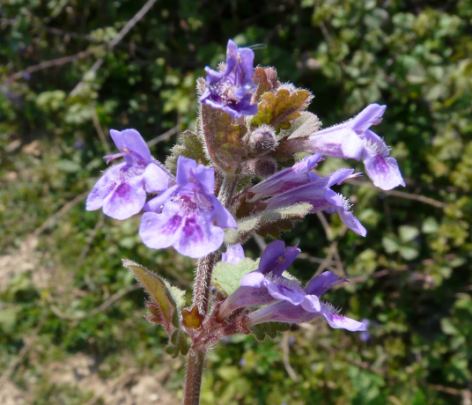
It was then I heard
it, just one short repeated note, but that was enough.
There is no other bird that sounds like a Nightingale.
I waited for a few minutes and gradually the bird got
into its full singing mode with rapid sequences of
chook notes, liquid and vibrating trills and slower
piu piu - which always sends shivers down my spine.
Just brilliant.
The bird was singing from a Hawthorn bush about 50
yards east of the amenity tip. Look as I did, I just
could not see or even get a glimpse of the bird. I
think to get a really good view and a photo of a
Nightingale you need to go to Pulborough Brooks as
Tony Wootton did a few days ago.
Water
Vole crisis
I am very
grateful to Graham Roberts of the Hampshire Wildlife
Trust for taking time to reply to last night's cry for
help over the plight of the Brook Meadow Water
Voles.
"Thank you for copying me in on your concerns for
Water Voles at Brook Meadow. I hope the following
comments may provide some guidance built on my
experience and possibly re-assure you. Water Vole
numbers really do fluctuate like Lemmings and you have
good and bad years depending particularly on
environmental conditions. Our Water Vole population at
one of the Trust's best reserves on the Itchen vary
considerably every year. Last year we had really bad
flooding at several critical times and numbers still
have not fully recovered.
Is there any chance you have a resident or transient
Mink in the vicinity? It only takes one to often wipe
out all water voles within 5km of their main lying up
site. Have you put out a "mink raft" to check if this
may be the case.
With the relatively mild winter again it is possible
that Brown Rats have moved into the area and will
actively drive out water voles or worse case kill
their young or transfer fatal diseases to the
voles.
Has the bankside vegetation been left undisturbed?
I will be in the office next Tuesday morning if you
would like a chat. I am to retire from the Trust next
Thursday after 25 very happy years but still will be
retaining my e-mail to deal with such issues for the
coming year I hope. Well done on all your passion for
managing this special area."
Water
Vole sightings
It is uncanny.
After posting the Water Vole crisis report last night
about the acute lack of sightings, today we have had
two sightings for the first time this year! Colin
Brotherston saw one swimming in the region of the
fallen willow tree between the bank fences. Then,
Malcolm Phillips watched one for about 15 mins by the
deep water sign before it swan up past the sluice
gate. These two sightings might well have been of the
same vole, but WOW two sightings in one day!!
Unbelievable.
For
summary of this year's Water Vole sightings go to . .
.
http://www.brook-meadow.hampshire.org.uk/bm-water-voles-2015.html
While Malcolm was
watching the Water Vole would you believe it, but
two Pike went past side by side, they looked to
be about 18ins. There was a third Pike by the south
bridge. Gosh, this Pike news gets worse by the day.
Are they now hunting in packs?
Water
Voles in Westbourne
On the way
home from Marlpit Lane I stopped at Westbourne to have
a look at the canalised millstream at Westbourne where
Patrick Giles saw two Water Voles a few days ago. This
has always been a reliable spot to find Water Voles
over the years. The far bank has a lush growth of
vegetation, reeds, willowherb, Water-cress, etc, which
is ideal Water Vole habitat. I did not see any sign of
them while I was there, but it is worth keeping an eye
out for them when passing along this popular route.
Please let me know if you see one (or two).
Here
is the millstream at Westbourne where the Water Voles
were seen
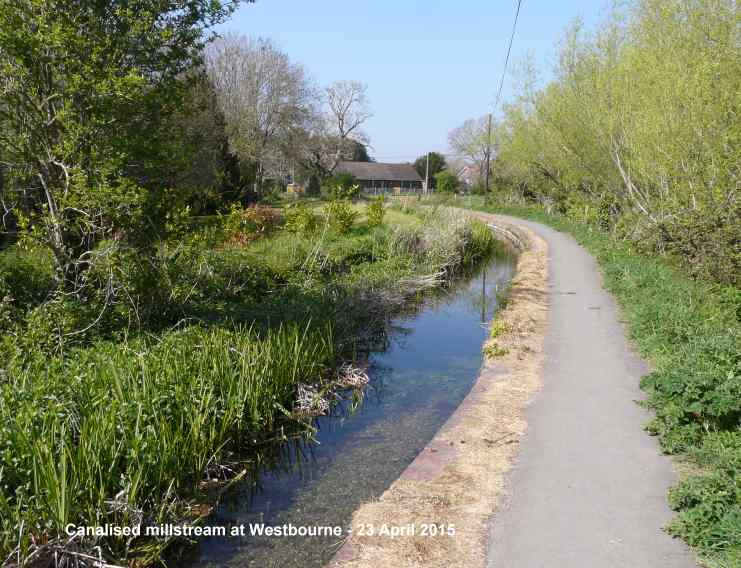
Warblington
shore
Peter
Milinets-Raby popped down to the Warblington shore
this morning (6:35am to 8:37am - very low tide and
cloudy). Not many highlights, but the best bits were
as follows:
Ibis Field/Cemetery extension: Pheasant male (see
Photo), Goldcrest singing, Blackcap and Chiffchaff
singing.
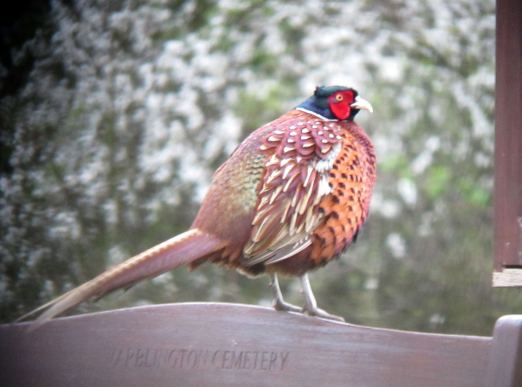
Conigar Point:
Blackcap, Chiffchaff Reed Warbler and Cetti's Warbler
heard, 7 Brent Geese, 10 Shelduck, 1 Greenshank, 34
Herring Gulls - non breeders gathering, 1 House Martin
heading east, 1 Whimbrel heading east and calling, 4
Swallows.
Pook Lane: 2 Greenshank, 3 female Red-Breasted
Merganser, 2 Bar-tailed Godwit, 3 Shelduck, 2
Black-tailed Godwit, 1 Linnet, 5 Med Gulls (numbers
now dropped as they settle down to breed).
Langstone Mill Pond: 2 male & 3 female Tufted
Duck, 3 singing Reed Warblers heard, Cetti's Warbler
and Chiffchaff heard, 3 Swallows.
Little Egrets - Very quiet and not many birds around.
All birds sitting on nests, so ideal time to count
before the leaves grow - 35 nests counted, but only
about 45 birds present.
Other
news
Chris Oakley
was fortunate to get this Large Red Damselfly
on some pea sticks in his garden where he was working
at the time. Chris thinks it may be an immature male
as the shoulder stripes are still yellow. This was the
first damselfly of the year in the local area.

Eric Eddles had a pair of Lesser Black-backed
Gulls for the first time on Baffins Pond today.
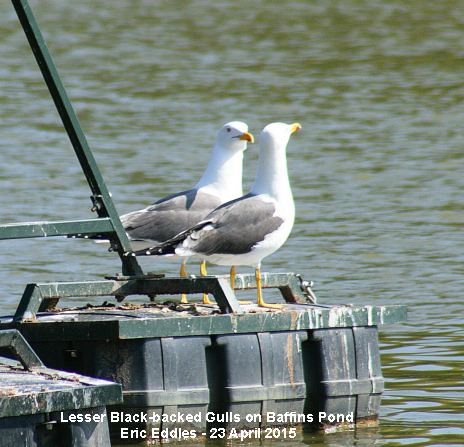
WEDNESDAY
APRIL 22 - 2015
Brook
Meadow
The tree
cutters were on the meadow when I arrived this
morning, having parked their lorry on the Seagull Lane
patch. They were lopping Crack Willows which Andy
Skeet had orange marked as being unsafe. The first to
go was the large branch overhanging the north bridge.
I got a shot of the men removing a large branch from a
tree in the south meadow, just catching it as the
branch fell.

I met Malcolm Phillips
and Robin Pottinger and we stopped for a chat about
butterflies, birds, Water Voles and inevitably those
Pike. Malcolm has a couple of contacts for local
fishermen who could help to catch these fish which are
serious predators of Water Voles. We noticed several
small Brown Trout swimming up stream from the sluice
gate area, so they have escaped the attentions of the
Pike. The first purple flowers of Common
Comfrey of the year were out on the river bank.
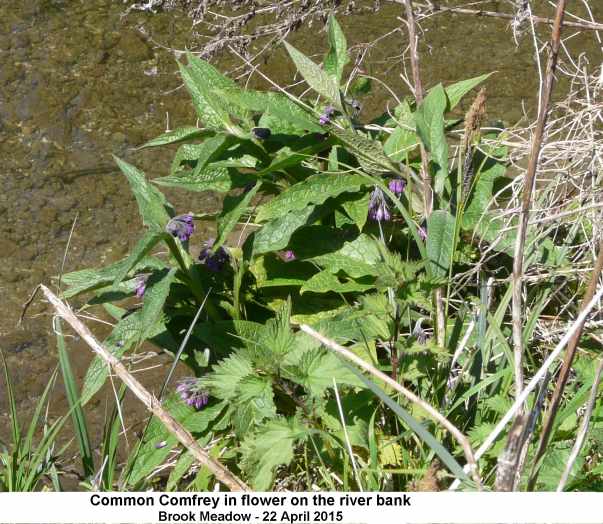
Malcolm sent a
selection of the bird photos he took on the meadow
this morning. Goldfinch, Greenfinch, Whitethroat and
Wren.
Water
Vole crisis
We have a
Water Vole crisis on our hands. Despite a good deal of
patient riverbank watching from Malcolm Phillips and
others, including myself, we have only had 7 reported
sightings of Water Voles on the River Ems this year.
We are now at the peak of the breeding season and we
should be getting lots of sightings. I have been
looking through the figures for previous years and
this year has the lowest number of sightings since
serious Water Vole recording started in year 2008.
Here are the totals until the end of April for these
years: 25 in 2008, 73 in 2009, 24 in 2010, 54 in 2011,
137 in 2012, 86 in 2013 and 26 in 2014.
Here is Malcolm's most recent photo of a Water Vole
taken by the Deep Water sign in Palmer's Road Copse on
17 February 2015 as a reminder as to what they look
like!

Water Voles numbers
were down last year probably due to the floods in the
winter of 2014 when many of their burrows were
completely underwater. However, numbers have not
recovered and the downward trend has continued which
suggests floods were not the only problem. The
presence of at least two Pike, one huge one up to 3
foot in length, in the river must be a factor in this
decline. Graham Roberts has confirmed that Pike of the
size will have a serious impact particularly on young
Water Voles. Maybe the Pike was the cause of last
year's decline in sightings which has continued into
this year.
Whatever is causing the Water Vole decline, it could
well be catastrophic. The Water Vole population is
relatively small and any change to the environment
could easily wipe them out completely as there is
little opportunity for any dispersal or new input from
elsewhere. I hope I am not painting a too depressing
picture, but the warning signs have been there for
some while and I think we need to take the problem
really seriously.
But what can we do? First thing is to remove the Pike
from the river. Brown Rats are another problem, though
less easy to solve. A professional Water Vole survey
of the river is needed to establish the facts about
signs, etc, of the sort carried out by Andy Rothwell
in 2007 and 2013. Andy's 2007 report provided some
management advice for the Water Vole habitat that have
not been properly implemented. Andy's findings in the
2013 survey were encouraging with Water Vole activity
prominent throughout the entire of the River Ems on
Brook Meadow. However, the survey was before the 2014
floods and probably before the Pike arrived.
See web site for links to Andy's survey reports . . .
http://www.brook-meadow.hampshire.org.uk/
Water
Voles in Westbourne
The fact that
the crisis discussed above might be restricted to
Brook Meadow is suggested by the observation by
Patrick Giles of two Water Voles
playing/mating/fighting in the Ems at Westbourne, in
the stretch just south of the church alongside the
path by the village hall with the long garden on the
western bank. Water Voles have been present in that
location for many years and clearly are still there!
Slipper
Millpond
A Great
Black-backed Gull was sitting on the nest this morning
with its mate on the water nearby. So, I think this
confirms their nesting and so I can start counting.
Incubation is 27-28 days from the laying of the last
egg. Assuming the last egg was laid today, my estimate
for hatching is about Wednesday 20th May.

The three remaining
Coot chicks were being fed by their parents on
the pond near the Hermitage Bridge.
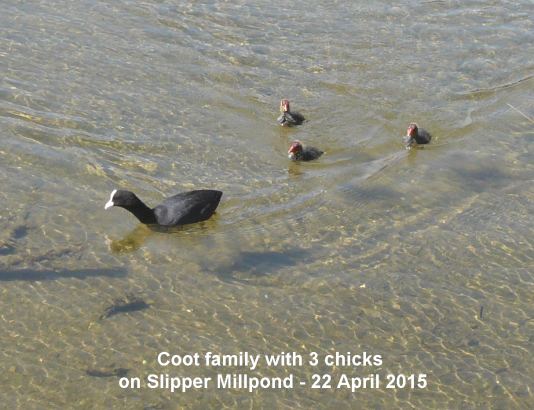
A Cetti's
Warbler was singing from the reedbeds at the north
of Peter Pond.
Langstone
Mill Pond
Peter
Milinets-Raby popped down to the Langstone Mill Pond
for an hour yesterday morning from 10am.
Pond: Cetti's Warbler, Reed Warbler and Chiffchaff
singing, 64 Little Egrets counted (see photo of one on
nest with two eggs).
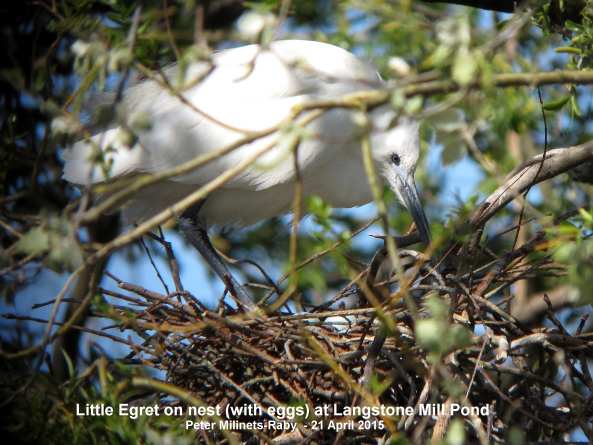
Young
Grey Heron
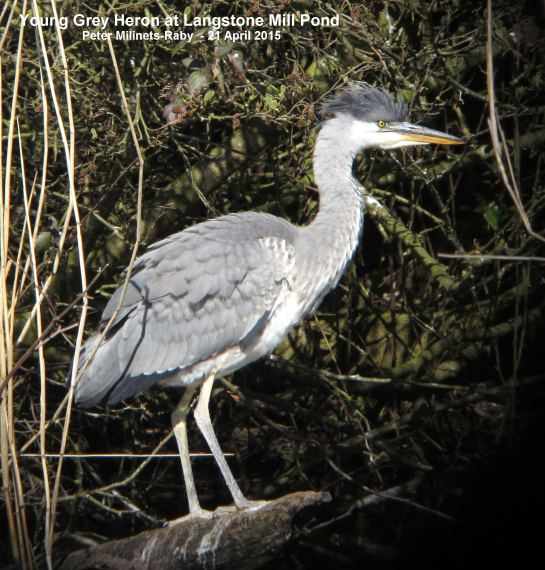
Off Pook Lane: 27
Black-tailed Godwit, 2 Sandwich Tern, Sand Martin
flying north.
Broad-bodied
Chaser
John Walton
was looking for butterflies in the scrub at the back
of Hayling Oysterbeds and came across this fabulous
dragonfly - a Broad-bodied Chaser. From the colour of
the abdomen this would appear to be an immature male.
Maybe, this was the first local dragonfly of the year?

TUESDAY
APRIL 21 - 2015
Millpond
News
The two
Great Black-backed Gulls were on Slipper Millpond
much as yesterday, on the water but not on the nesting
raft. However, later I met up with Glynis Irons and
her son Thomas who told me they had seen one of the
gulls climb onto the nest on the raft, so maybe things
are happening after all! I think the female is on the
left in this photo and the slightly larger male on the
right.
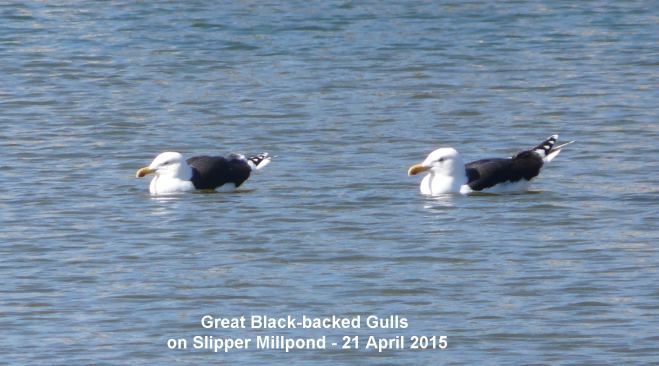
I could only see 3
Coot chicks being fed by their parents near the
reeds on the eastern side of the pond, down from four
yesterday. It seems that the large gulls may be
picking them off one by one.
The cob Mute Swan of the nesting pair remains on the
pond alone. There has been no sign of its missing mate
for a few weeks not, presumed dead.
Garlic Mustard is in flower on the east side of
the pond. The tiny pink flowers of Common
Stork's-bill are now showing on the grass verge at
the junction of Lumley Road with the main A259.
Spotted Medick was also out.
Brook
Meadow
Greater
Pond Sedge is now in full flower on the eastern
side of the Lumley area near the Lumley Stream, with
the male spikelets above and the female spikelets
below. As I mentioned before, the plant appears to be
encroaching into the main Lumley area which is a
little concerning. That is a 7-spot Ladybird on the
flower.
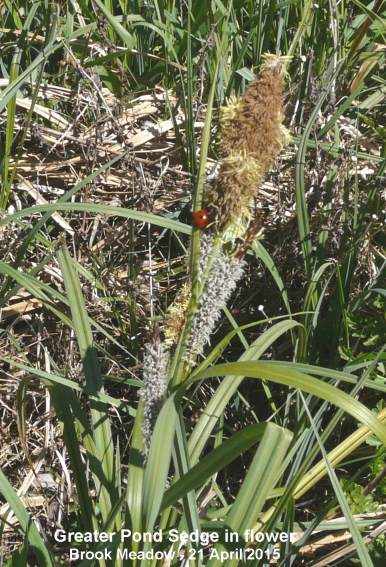
Distant Sedge
is now out on the Lumley area, but I can still not
find any Divided Sedge. Where has it gone? Silverweed
leaves are showing well across the area. Cow
Parsley is just starting to emerge along the edge
of the main river path and soon should be a glorious
sight.
I spotted a Grey Heron in the river near the
S-bend and managed to get a quick shot of it before it
saw me and flew off. Grey Heron is a fairly regular
bird in the river on the meadow, though easily
disturbed.

Thomas Irons and his
mother Glynis took a walk through Brook Meadow and
spotted a red-tailed Bumblebee feeding on a Dandelion
flower. The photo is not too clear, but from the
overall dark body my guess is Bombus
lapidarius. This is one of the most common
Bumblebees, being widespread across most of England
and Wales.
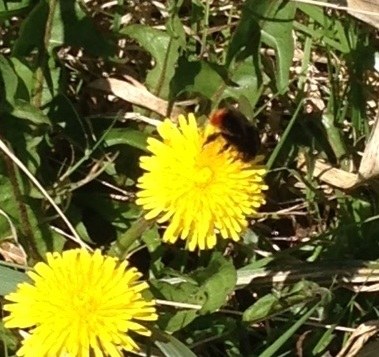
Malcolm Phillips has
been watching two large Pike from the south
bridge today. He says trying to judge the size is not
easy but he put a 2ft stick in the water and got a
photo as it passed the smaller Pike; the large Pike
was about a foot longer than the stick. Here is
Malcolm's photo of the smaller Pike with part of the
stick.
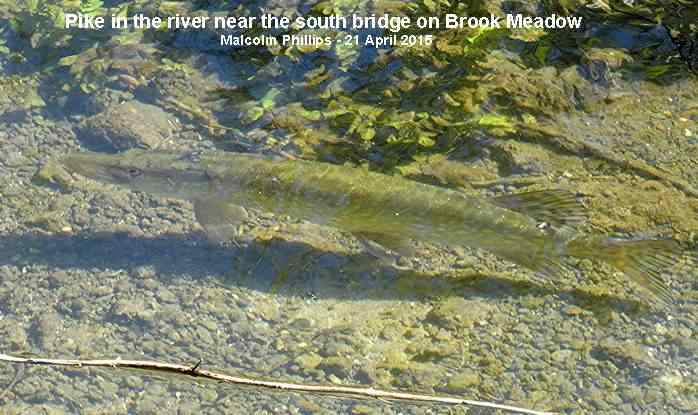
Francis Kinsella took
advantage of the glorious weather yesterday to have a
look for butterflies on Brook Meadow and found a good
number including Peacocks, Comma, Small Tortoiseshells
and lots of Speckled Woods. Francis also had Orange
Tip, Holly Blue and Green Veined White which have been
the latest to appear. Here is a selection of his
photos.
Comma
- Speckled Wood - Holly Blue - Orange Tip
Bridge
Road Wayside
I did a litter
pick on the wayside this afternoon. The litter was
abundant, including the usual empty bottles of
Vodka.
On a brighter note Barren Brome grass is now
flowering very well (and a bit earlier than usual) so
I picked a few stems for the wildlife display on my
desk in the window. Its drooping spikelets create a
very attractive display both for myself and,
hopefully, for people passing by.
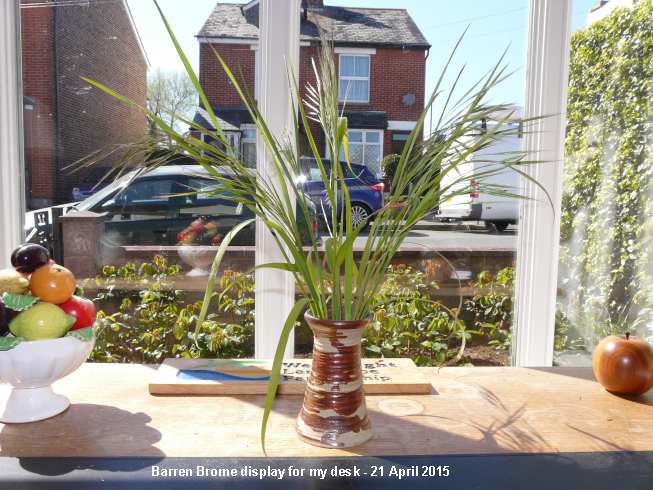
Hampshire
Farm
Chris Oakley
took a walk over to the pond on the Hampshire Farm
open space and was pleasantly surprised. He found the
water was crystal clear and there was a lot of surface
insect movement. Chris was hoping to see an early
damselfly, but no luck. The pair of Mallard are still
there but no sign of a nest yet. The water level is
quite low and there is a heavy cover of Duckweed and
blanket algae which Chris says should not be touched
as it is probably full of dragonfly larvae. The
Stream Water-crowfoot has formed several large
patches and their trailing white and yellow flowers
are looking splendid.

Around the rim,
clusters of the Celery-leaved Buttercup are beginning
to flower as well as luxuriant patches of Trailing
Buttercup actually growing in the water that could
easily be mistaken for Kingcups. Apart from the
regular spring flowers around the banks Chris spotted
some Coltsfoot, now coming to the end of its flowering
time but still a pleasure to see. Chris will continue
with visits to the pond and has updated his website
accordingly. See . . . http://www.hampshirefarm.co.uk/
Rachel Moroney of the BTV is hoping to form a Friends
of Hampshire Farm group, which is a very good move.
Let's hope lots of people get involved so we can have
another thriving conservation group in Emsworth.
Other
bird news
Paul Cooper
reported that he had just seen the first House
Martins of the year, flying over Lynch Down,
Funtington. He hopes there will be more and they nest
successfully again.
Tony and Hilary
Wootton went round Pulborough Brooks RSPB Reserve
today and got a cracking photo of one of their
Nightingales. I wonder if they have arrived yet
at Marlpit Lane?

The
Island Bee-eaters
A story has
been dominating Hoslist regarding the Bee-eaters that
bred on the Isle of Wight this summer.
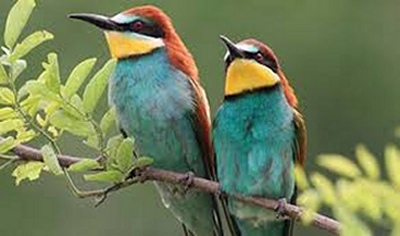
The rumour was that
they could have been escapees from a collection and
not wild birds. My son who lives and works on the
island asked the RSPB warden who told him it was
nonsense for the following reasons:
- no-one reported any escaped bee-eaters;
- their arrival occurred at the same time that
migrants usually arrive;
- their plumage showed no sign of having been caged
(captive birds usually show wear and tear);
- their movement in flight was of an agility that
would not be expected of a bird that had been
caged;
- they departed at the same time as migrants usually
go. Had they been escapees they probably would not
have gone.
These guys sat and watched the birds for the best part
of the summer. I think that if there was a hint that
they were escapees they would have picked up on it. I
think that looks pretty conclusive.
Butterflies
of 2015
Ralph Hollins
summarises the dates on which the first butterflies
appeared in 2015:
March - first sightings of Small Tortoiseshell on 1st;
Small White 3rd; Brimstone 5th; Comma 7th; Peacock
8th; Speckled Wood 10th and both Green Veined White
and Small Copper 18th. Red Admiral was seen even
earlier, in three counties on January 1st.
April - first sightings of Large Tortoiseshell on 5th;
Orange Tip, Painted Lady and Holly Blue on 6th; Dingy
Skipper and Scarce Tortoiseshell on 7th; Clouded
Yellow and Wall Brown on 8th; Grizzled Skipper on 9th;
Duke of Burgundy on 14th and Green Hairstreak on
15th.
For more about the Large and Scarce Tortoiseshell
sightings go to the Sussex Butterfly Conservation
website and in particular look at the entry for
Wednesday 8 April where Neil Hulme has posted
annotated photos with detailed guidance for
identifying these rare species. http://www.sussex-butterflies.org.uk/sightings.html
MONDAY
APRIL 20 - 2015
Millpond
News
The cob swan
was on the reed nest on the town millpond when I
passed by this morning. The pen was having a break
further up on the pond.
Not much else apart from gulls, mostly Black-headed
Gulls, though there were a couple of Herring Gulls and
one Lesser Black-backed Gull. This bird is
easily distinguished from the Great Black-backed Gull
not only by its smaller size, but by its yellow legs.
The Great Black-backed Gull has pink legs.

I noticed a good
growth of Sticky Mouse-ear on the edge of the
millpond along Bridgefoot Path. This distinctive plant
was also present at the base of the Hermitage Bridge.
It is easily distinguished from Common Mouse-ear from
its tight cluster of barely open flowers and its
generally sticky appearance.
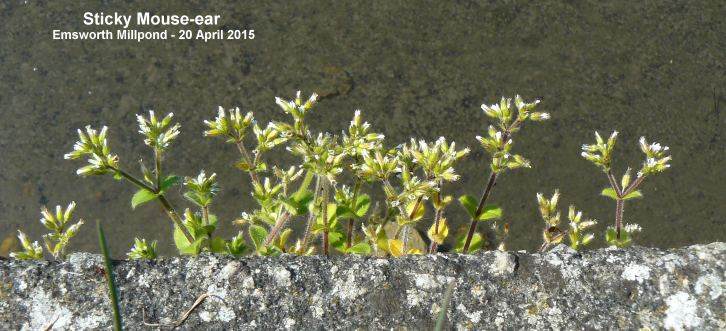
Over on Slipper
Millpond I was surprised to find the pair of Great
Black-backed Gulls on the water and not on the
raft where I saw them on the nest just two days ago on
April 18. In the 30 minutes or so I was there the two
gulls swam around in the general vicinity of the raft,
but never once went onto it. This is unusual behaviour
and suggests no eggs have yet been laid.
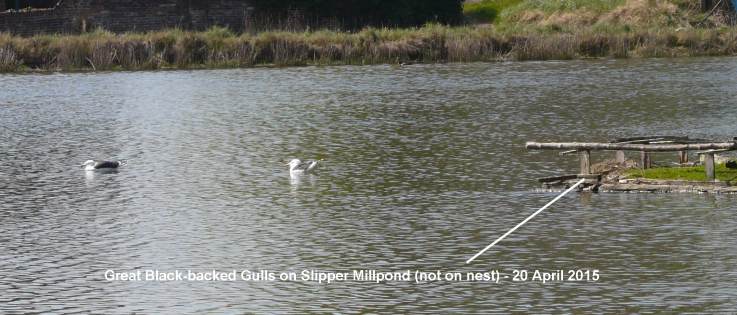
The lone cob Mute Swan
was still present on the pond.
I could see four Coot chicks being fed by the
two parents near the reeds at the east side of the
pond, one less chick than on my last visit a couple of
days ago. I expect more to disappear with the big
gulls on the pond.

Orpine
in Lyels Wood
I am grateful
to Ralph Hollins and Martin Hampton for pointing out
that the Ice Plant that I found in Lyels Wood
yesterday could well be the relatively rare wild plant
called Orpine (Sedum telephium). Ralph says the
photo shows the leaves are alternate which indicates
the genuine wild plant.
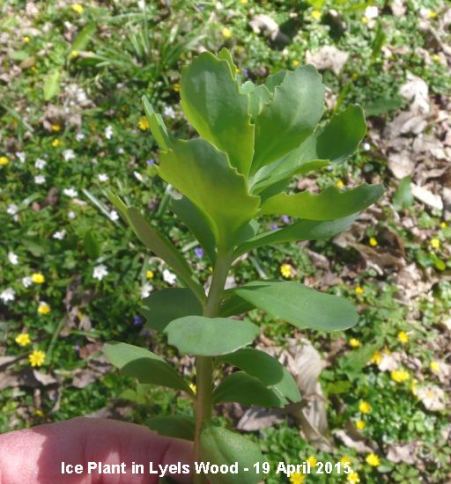
Ralph provided the
following link for more photos of Orpine . . .
http://www.wildflowerfinder.org.uk/Flowers/O/Orpine/Orpine.htm
I must go to Lyels Wood in July to see them in flower.
This news sent me to
my records again. Previously I had searched for Ice
Plant and came up with nothing. But searching for
Orpine produced two previous encounters with this
plant that I had only vague memories of.
On Saturday May 31, 2003 I was on a walk through Lyels
Wood with the Havant Wildlife Group when we discovered
what is possibly the same Orpine plant. The walk was
led by Gwynne Johnson and I have a note to say that
Nigel used his new GPS device to give the following
grid ref SU 7470 1023 for the plant. That looks spot
on for the plant I found yesterday.
The Sussex Plant Atlas for 1966-78 records Orpine as
being present in SU71K which is the location for Lyels
Wood. So, it looks as if the plant has been there for
many years.
The New Atlas
describes Orpine as . . . "A perennial herb, found on
wood-borders, hedge banks, roadsides, rocky banks and
in limestone pavement, often in very small but very
persistent colonies. It also occurs as an uncommon
ancient woodland plant, but sometimes fails to flower
in this habitat. Athough native in some habitats, many
colonies have become naturalised near houses as this
species is grown in gardens, and the native range is
now hopelessly obscured by such escapes; all British
records are mapped as if they are native. Eurasian
Temperate element; widely naturalised outside its
native range."
Malcolm's
news
Malcolm
Phillips got some nice birds at the top of Peter Pond
today. They included a Whitethroat and male and
female Blackcaps.
The Ladybird looks
suspiciously like a Harlequin with those prominent
white 'cheeks'.
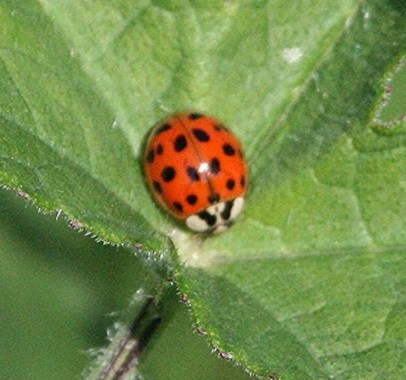
Other
news
Christopher
Evans was on Brook Meadow today and spotted this
domestic cat partly hidden in the bushes near
the river. That is not good news. Our dwindling
population of Water Voles is already under serious
threat of extinction from a huge Pike in the river.
Now it also has to contend with another equally fierce
predator.
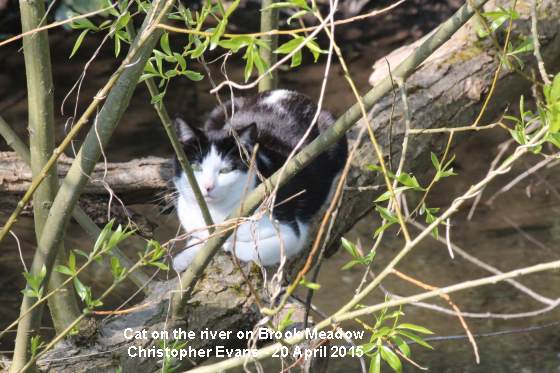
Christopher also
captured this image of a flock of Carrion Crows
roosting in trees near Warblington Farm. Carrion Crows
traditionally roost in large flocks sometimes several
hundred strong.
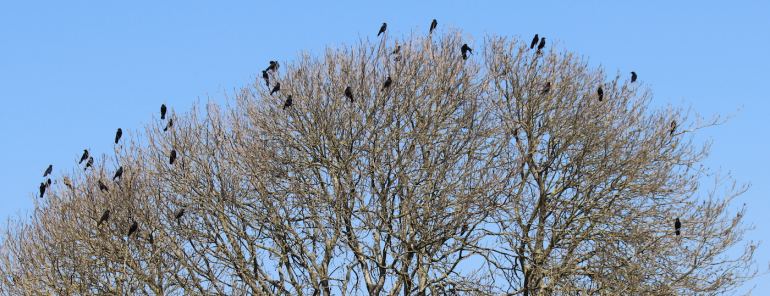
Eric Eddles discovered a pair of Gadwall on
Baffins Pond today, a first for him and probably for
the pond also?
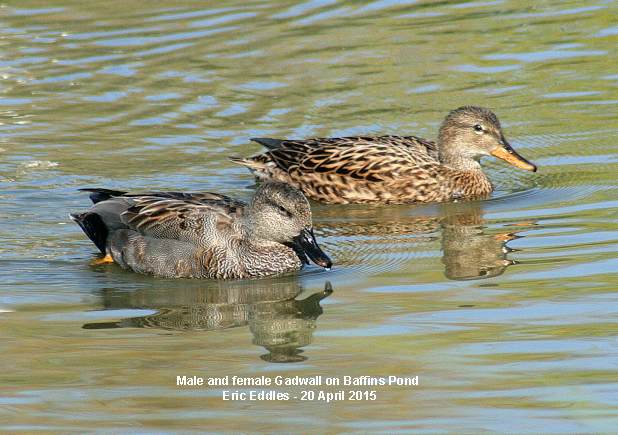
SUNDAY
APRIL 19 - 2015
Lyels
Wood
This morning
Jean and I had a stroll through Lyels Wood
conservation area in Stansted Forest. Lyels Wood is
located to the south of the main avenue about 500
yards west of the car park. Due to its wildlife
importance, access to Lyels Wood is restricted to
people with an interest in wildlife study. We both
have permission from Michael Prior the Head Forester
to walk through the site.
Bluebells were emerging, though not yet on the
scale or density as those in Ashling Wood. In addition
we enjoyed seeing excellent displays of wild Primroses
along the paths.
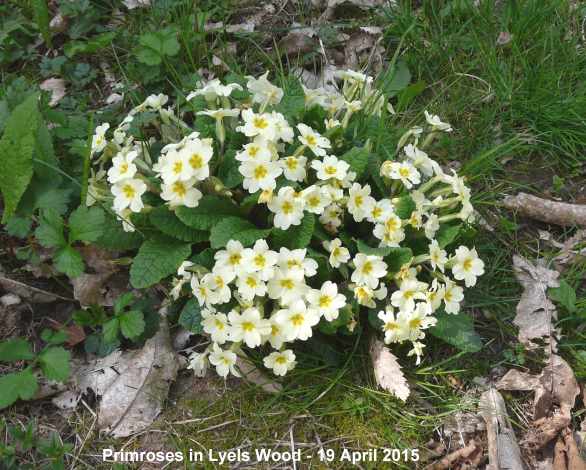
Also flowering well
were Wood Anemones, Lesser Celandines and Common
Dog-violets. Dog-violets, in particular, seem to be
particularly abundant everywhere this year.
We also noted small quantities of Barren Strawberry,
Wavy Bitter-cress and Bugle in flower. Ralph
Hollins also noted Bugle in flower in Havant.
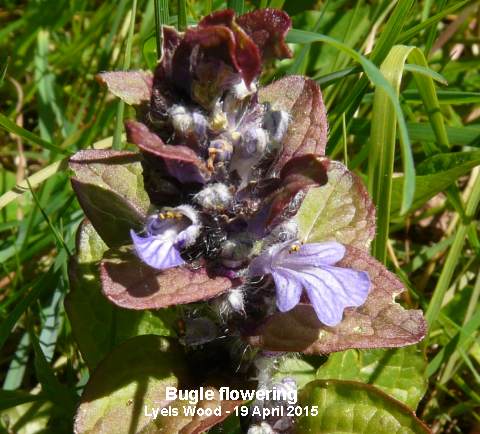
Wood Spurge and Yellow
Archangel were in bud and not far from flowering. In
one area we found a nice patch of Sweet Vernal
Grass (my first of the year) and Field
Wood-rush.
We also came across what we both recognised as an
Ice Plant. This is a common garden plant, but
how did it get into a conservation area? I have a
recollection of having seen this Ice Plant in Lyels
Wood before, but cannot find any record of it.

Butterflies seen
included Peacock and Orange Tip, the latter
feeding on Wood Anemones and Common Dog-violets. The
following photos show a female Orange Tip feeding in
Lyels Wood.
On the left the insect is feeding on Wood Anemone and
showing its white upper wings with grey tips.
On the right the same butterfly is feeding on Common
Dog-violet and showing its mottled green underwings.
Cornsalad
What I assume
is Keel-fruited Cornsalad (V. carinata)
is flowering around the wall of my son's house in
Church Path, Emsworth. This is a fairly common plant
around the town where it flourishes on the edge of
pavements. Apparently, this is the default Cornsalad
species in Hampshire and not Common Cornsalad (V.
locusta). Keel-fruited Cornsalad gets its name from
its deeply grooved and keeled fruits.

Swarm
of flies
Ralph Hollins
thinks the swarm of flies I found near the Thorney
Little Deeps on Apr 14 could well be Chironomus
plumosus or the Buzzer Midge. See page 194
of the Chinery Collins Guide and http://www.naturespot.org.uk/species/chironomus-plumosus
Here
is one resting on a Gorse flower that I took at the
time
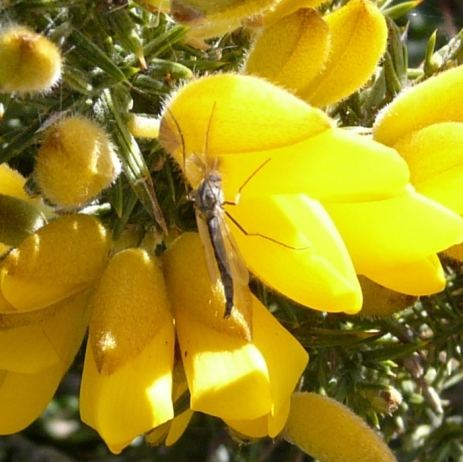
This is the largest
non-biting midge. It has a range of colour forms from
green, ginger, brown and black. The male has a pair of
prominent plumes. There is a dark band at the end of
each abdominal segment. Often around water during
periods of egg laying by the females and at the
hatching of adults. Usually seen during spring and
summer when males create mating swarms which people
can find quite a nuisance even though adults do not
bite or feed. The larvae of chironomid midges are
called 'bloodworms' and they live at the bottom of
lakes and rivers. The pupa floats to the surface where
the adult then hatches out. They are very vulnerable
to predation at this stage and rising trout and other
fish are often feeding on this species. Very common
species in Britain.
Pond
Skaters
I am not sure
why I called the water insects in the Westbrook Stream
Whirly-gig beetles, but as Ralph Hollins kindly
pointed out they were, of course, Pond Skaters.
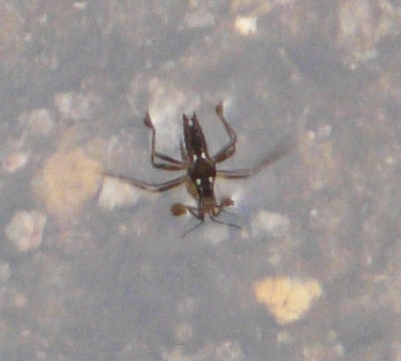
I have seen them there
in previous years. Another senior moment, I am afraid.
Ralph added that there are around 350 species in the
Gerridae family to which the Pond Skater belongs and
they seem to have many English names. He has always
called them Pond Skaters, so I shall continue to do
that in future!
Ralph recommends . . . http://www.britannica.com/EBchecked/topic/637289/water-strider
Nore
Barn
Charlie
Annalls was at Nore Barn yesterday and found the
regular colour-ringed Greenshank G+GL still
present in the stream. Its usual feeding companion,
the Spotted Redshank, has long since left for its
breeding grounds in Northern Scandinavia. Here is the
Greenshank stretching its wings.
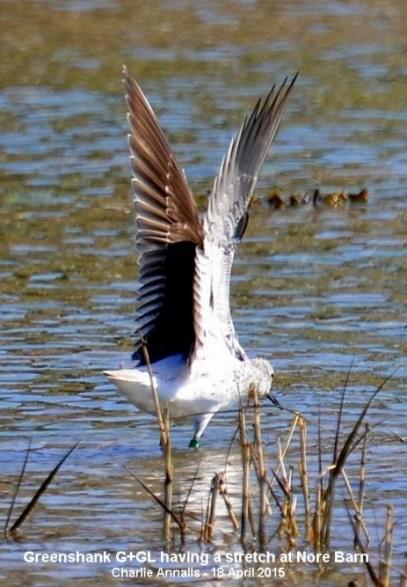
Charlie also commented on
"an amazing number of Greenfinch - almost
everywhere I looked but they were very yellow in the
bright sunshine, more like canaries!" The very yellow
ones will be males, the colours of which become much
much brighter in the spring through feather wear.

Other
news
Malcolm
Phillips spotted this Moorhen sitting on her nest
near the S-bend in the river on Brook Meadow
today.
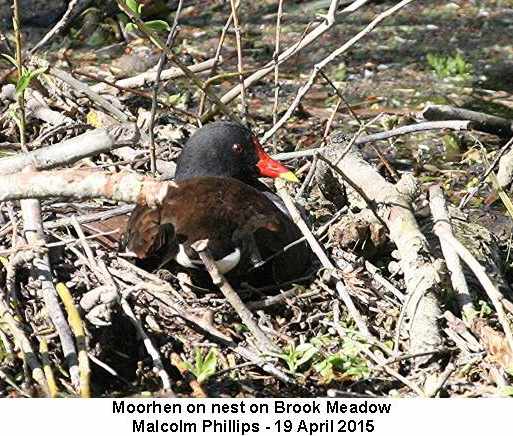
Tony Wootton captured this nice image of a male
Blackbird feeding one of its youngsters.

The Irons family had a good time at Baffins Pond this
morning. Young Thomas managed to get a shot of a
cob swan chasing off an intruding swan.
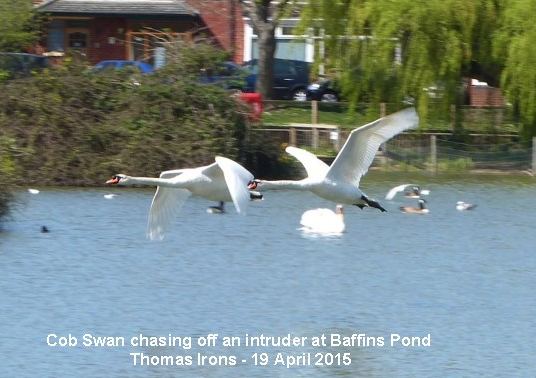
SATURDAY
APRIL 18 - 2015
Ashling
Wood
Jean and I
headed to Ashling Wood to see how the Bluebells were
getting on. Well, they were magnificent, a wonderful
sight. Well worth visiting the site.

The woods provided a
great mixture of colours with the Bluebells combining
with the white flowers of Wood Anemone, the yellows of
Lesser Celandine and the violets of Common Dog-violet.
I could not capture it in a photo, so here is a
Common Dog-violet.
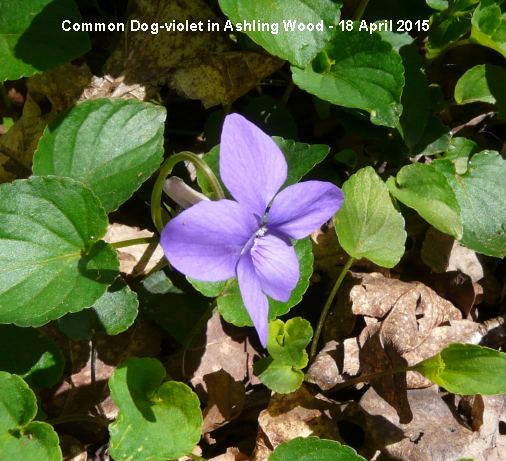
Walking through the
woods towards to the lane to West Stoke we came across
a magnificent display of Dandelions in a large
field with the Old Rectory house in the distance.
Probably as spectacular as the Bluebells.
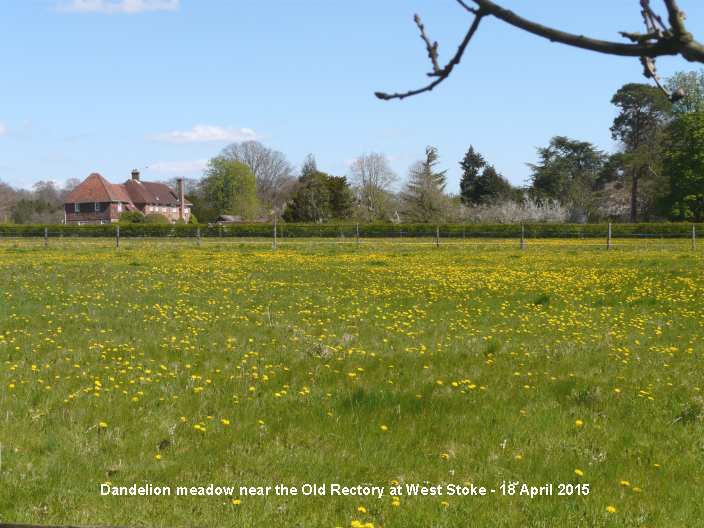
We walked back to the
car along the lane towards West Stoke. There we found
a Cherry Laurel in full flower and Greater
Stitchwort in the hedgerows.
We returned to
Emsworth via West Ashling pond where we found one
Black Swan. There are usually several on the
pond. I wonder if they will nest there this year?
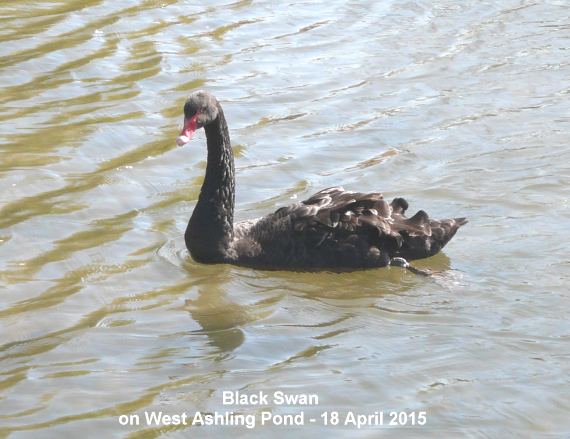
We also called in at
Marlpit Lane, but there was no sound of any
Nightingales. Probably not yet arrived, though
they are singing at Pulborough Brooks.
Slipper
Millpond
Back in
Emsworth, we stopped at Slipper Millpond where the
pair of Great Black-backed Gulls were back on
the centre raft with the female sitting on a nest and
the male standing guard. So, they are nesting here
after all. I really thought they might have left it
too late, but no. This will be their 4th year running
on the raft.
Is that a third Great Black-backed Gull on the water
in the background? That is interesting! Could it be
one of the young birds from earlier years, although
the plumage looks well developed. I suppose it could
be a Lesser Black-backed Gull.
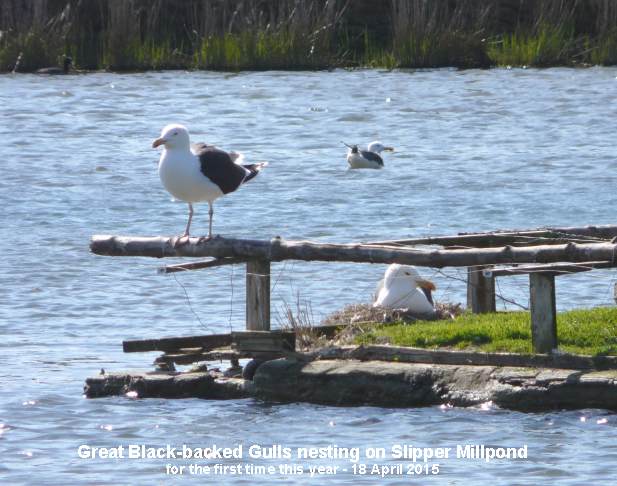
Mystery
fly
The mystery of
the mystery fly that I found feeding on Cuckooflowers
on April 16 deepens. Tony Davis wrote to say it is a
hoverfly (as I first thought) but is not Syrphus
ribesii as Ralph Hollins considered it might be in
yesterday's blog. Rather it is in the genus
Sphaerophoria but is a female and
females in this genus cannot be identified to species.
So, maybe that is as far as we shall be able to go
with this one.
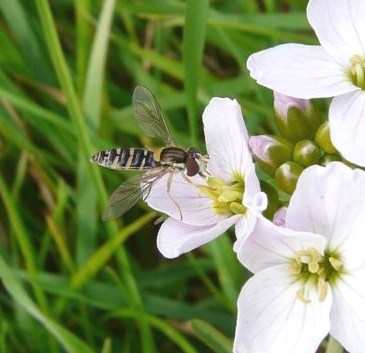
I gather from the
internet that hoverflies in the genus Sphaerophoria
are small to medium size flies with bright yellow
markings on head, thorax and abdomen. There are some
entirely black species also. Also their body is longer
than wings. There are 14 species and their larvae are
predators of aphids.
Brook
Meadow
Malcolm
Phillips was on the meadow this morning. He got two
photos of fish near the sluice gate. He is sure this
one is a Pike.
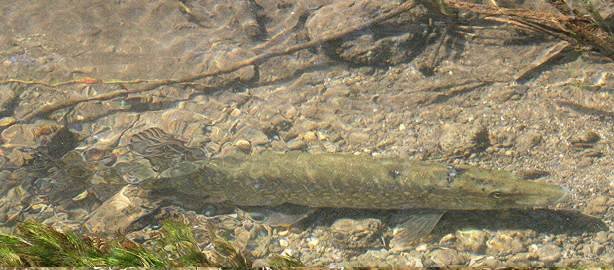
But he is not sure of
the other one which has black spots on its back. Could
it be a young Pike? It looks the same general shape as
a Pike.
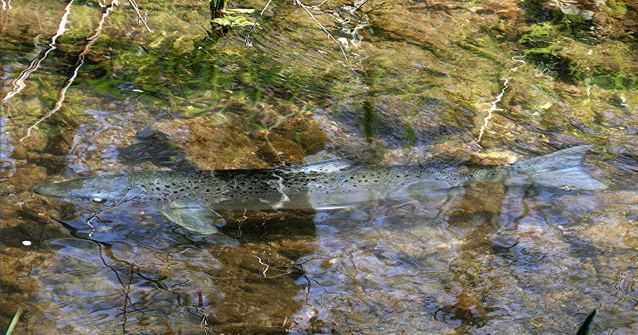
Malcolm also sent me
various butterfly photos. This one caught my eye as it
could have been the same insect that he photographed
yesterday. Then he got the distinctive underwings of a
Green-veined White, today he got the less distinctive
upperwings of a Green-veined White - probably a
male?
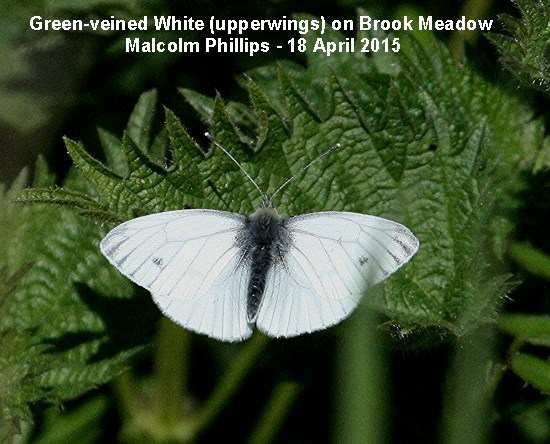
Warblington
shore
Peter
Milinets-Raby was out this morning for a walk along
the Warblington shore (6:38am to 9am - low tide). Very
few migrants. Peter says - Looking at my report for
the last two years, the area does not really get many
migrants during the spring and today was a typical
day. Highlights today:
Warblington cemetery: Briefly singing Whitethroat
along the southern edge, a migrant moving through.
Ibis Field: male Pheasant, Blackcap 2 singing and
holding territory, Chiffchaff 2 singing and holding
territory, 2 Moorhen, Cetti's Warbler singing (a
different bird from the one at the mini reed bed - so
four in the area (Langstone Mill Pond, Brook Meadow,
Conigar Point and Ibis Field).
Conigar Point: Reed Warbler and Cetti's Warbler
singing from mini reed bed, 3 Shelduck, 1 Great
Black-backed Gull, 4 Med Gull west,
Pook Lane: 10 Shelduck, 2 Greenshank (RG//-+YY//-), 73
Black-tailed Godwit (3/4 in summer plumage), 14
Bar-tailed Godwit (all still in winter plumage), 2
Whimbrel (see photo), 9 Med Gulls off the
Castle Farm fields (4 pairs & a first summer), 2
Swallow collecting mud from the shore to build nests
in nearby farm buildings - no others seen.

Horse Paddock: 1
Mistle Thrush, 1 Green Woodpecker, 2 Moorhen,
Langstone Mill Pond: Reed Warbler & Cetti's
Warbler singing, Reed Bunting male, Chiffchaff singing
(No Willow Warblers - all moved through).
The Seventh nest was an old Little Egrets nest and now
occupied by Little Egrets.
Middle Grey Heron nest with tiny young - movement
seen, but not numbers
Holm Oak - Viewed from the gate by the horse paddock -
nice clear view now the scrub has gone!! There were
four juveniles on the top nest and two on a NEST
behind the top nest (This nest is not visible from the
usual viewing point. Could this be where the odd
youngster appeared from?) So there could have been a
seventh hidden nest at the back of the Holm Oak? I
counted 23 Little Egrets sitting on nests.
Hook-with-Warsash
Chris Cope
reported on this morning's walk by the Havant Wildlife
Group:
For the report go to . . . Havant
Wildlife Group
- see link to 2015 reports.
FRIDAY
APRIL 17 - 2015
Mystery
fly
Ralph Hollins
thinks the small fly in last night's blog feeding on
Cuckooflowers (April 15) which I tentatively
identified as Atherix ibis is more likely to be
the Hoverfly Syrphus ribesii For more
information on this hoverfly go to . .
http://www.naturespot.org.uk/species/syrphus-ribesii
.

Ralph is not entirely
confident with this id but he notes the semi-circular
yellow pad at the rear of the thorax and the central
break in the frontmost yellow cross band. While the
Nature Spot photos do have the longitudinal stripes on
the thorax Ralph says he would always go for a common
species rather than a rarity. Very sensible advice.
Thanks Ralph.
North
Thorney
Tony Wootton
got out of bed early this morning to get down to North
Thorney by 7am and it paid off handsomely with some
cracking photos. As he walked along the old NRA track
a Cuckoo flew in from the east, probably the
same one that I heard calling constantly a couple of
days ago. Tony managed to get a shot of it perched in
a tree before it flew away.
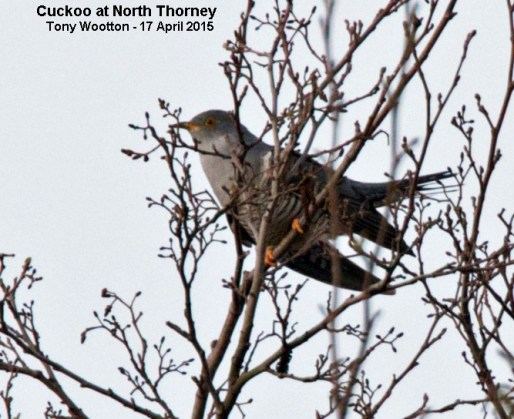
Tony also saw and got
a photo of one of the several Cetti's Warblers
that singing from the bushes along this track.
That bird is a great challenge to any photographer.
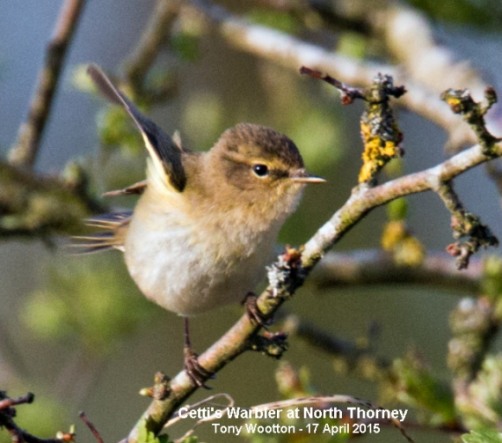
Before he left the
area Tony got photos of a couple of much easier
subjects perched on the overhead cables, namely the
pair of Swallows that I hope will be nesting as
usual in the old stables to the north of the track,
though I have not been along there to see whether it
is still suitable for them.
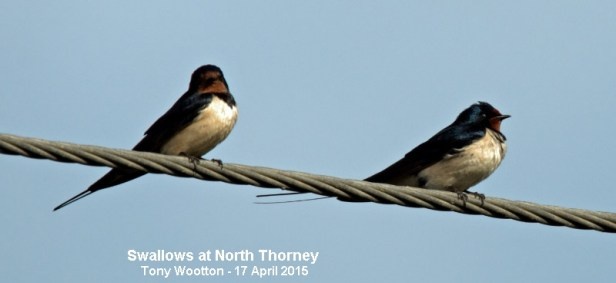
Finally, Tony snapped
this rather nice male Linnet just getting into
its summer plumage.
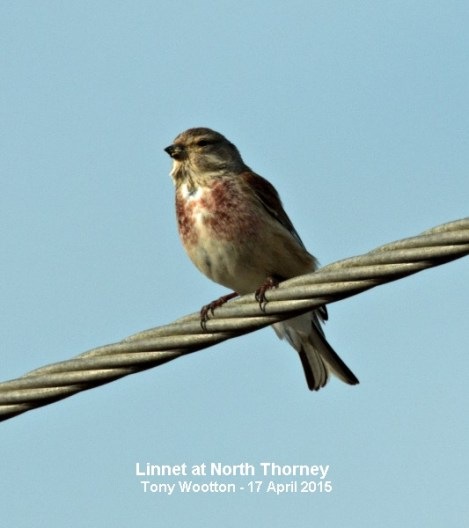
Barry
Collins news
Barry Collins
reports on the SOS sightings list: "A Marsh
Harrier flew N low over the Great Deep on the west
side at 11.10 this morning and disturbed 16 Greenshank
as it did so. On the east side of the Great Deep the
4 immature Spoonbills were roosting throughout
the high tide period."
On April 15th Barry reported 3 Cuckoos at various
sites around the Island, plus 4 Sedge Warblers, Reed
Warbler, 3 Whitethroats, 10 Cetti's Warblers, 5
Wheatears and a flock of 250 Linnets.
Slipper
Millpond
From Thorney
Tony Wootton made his way to Slipper Millpond where he
found the pair of Great Black-backed Gulls on
the water.
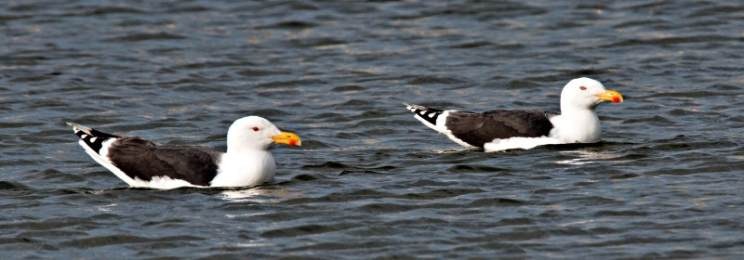
One of them went onto
the raft while he was there and looked threateningly
at a Black-headed Gull. If I were that gull I would
get away swiftly while the going was good. So maybe
the Great Black-backed Gulls have not given up on
nesting here again this year?

Tony could only find
4 Coot chicks on the pond by the north raft
where there had been 5/6 previously. It seems highly
likely that the missing two chicks have been taken by
the gulls and one can't hold out much hope the others.
Brook
Meadow
Malcolm
Phillips was on Brook Meadow as usual today where he
got this photo of a Green-veined White
butterfly. This butterfly which is easily identified
by its heavily veined underwings, is generally not as
common as the cabbage whites (Large and Small White),
but unlike them it has a rather weak fluttering flight
and is often seen low down among vegetation. It also
does does not lay its eggs on cabbages, but prefers
crucifers such as Garlic Mustard.
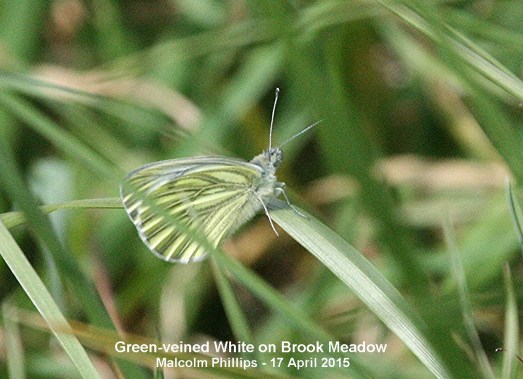
Migrants
arrive in force
The British
Trust for Ornithology report that the light winds and
warm temperatures during the last week provided the
perfect conditions for migrant birds held up in
southern Europe to continue their journeys north.
Swallows, Willow Warblers and Ring Ouzels arrived in
force. Cuckoos were heard from at least sixteen
different counties, the most northerly near
Manchester. The BTO satellite-tagged Cuckoos are also
making their way north with four having completed
their Sahara crossing.
See . . . http://bto-enews.org/IG4-3AZAJ-3RN36S-1K3ORR-0/c.aspx
THURSDAY
APRIL 16 - 2015
Bridge
Road Wayside
Ivy-leaved
Toadflax is in flower on the wall of the stream.
Two good patches of Slender Speedwell with the
rounded leaves are out on the grass verge. White
Comfrey is flowering again on the east bank of the
stream behind the signcase. Spanish Bluebell is
flowering on the north shrubbery. Two new grasses were
Meadow Foxtail and Barren Brome.
I found a clump of
Dog-violets flowering in the far eastern corner. I am
inclined to go for Early Dog-violet rather than
Common Dog-violet due to the following (based on Rose
New Ed p. 186): (1) spur straight, pointed, unnotched
and violet; (2) purple veins on lower petal slightly
branched.
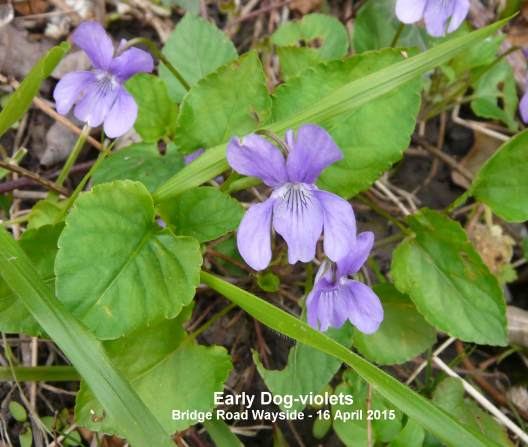
I did a recount of the
Cuckooflowers on the wayside which came to 338.
This is a big increase on the 120 counted just three
days ago on April 13. It will be interesting to see
the final total.
I spotted a small fly feeding on one of the
Cuckooflowers. It looked at first like a hoverfly but
not one I recognised. It has a dark abdomen with broad
pale stripes across and a dark thorax with pale
stripes lengthwise. Looking through Chinery's Collins
Guide to Insects my tentative guess is Atherix
ibis. This could be a female with the grey
stripes on the thorax.

Mystery
water insects
Several
beetles were darting around on the slow moving
Westbrook Stream below the small bridge at Victoria
Road when I passed by this morning. I have seen them
here in previous years and have always called them
Whirly-gig Beetles. However, I took some photos of
them today which did not look like that species. The
insects in the stream had long bodies and legs, unlike
the Whirligig Beetles which have oval shaped bodies
and shortish legs. Any ideas about what they are
please?
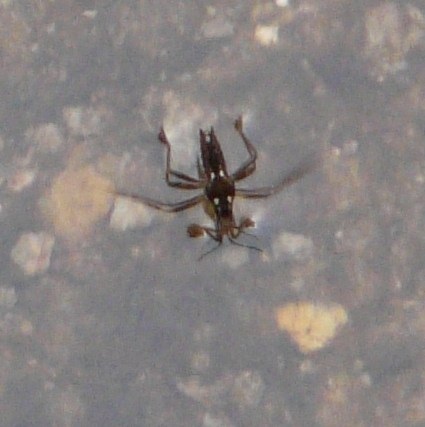
Brook
Meadow
I went over to
the meadow this morning for the regular conservation
work session attended by 9 volunteers. The main job
was to continue clearing of the brambles around the
causeway and those climbing up the Alder Buckthorn
trees. We were very aware of the need to avoid any
disturbance to wildlife at this sensitive time of the
year.
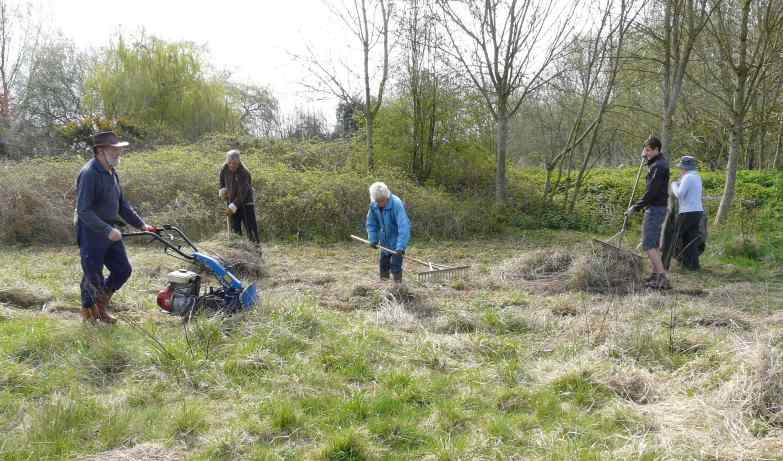
Wildlife
observations
A 7-spot
Ladybird was on the Seagull Lane patch.
Interestingly, all the Ladybirds I have seen so far
this year have been natives. I have yet to see a
Harlequin Ladybird. Maybe they have died out?

I spotted some
Bittercress growing on the wet mud of the river bank
near the sluice gate which had the the wavy stem
typical of Wavy Bitter-cress. It was also in
the right wet habitat for this plant.
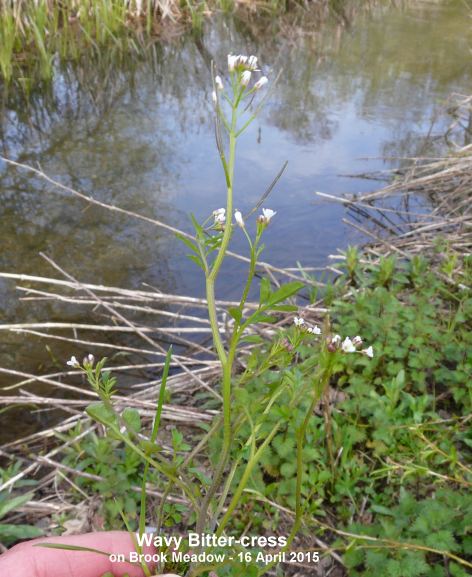
I checked the flowers
with the microscope at home and they had the required
6 stamens which confirmed it as Wavy Bitter-cress. The
very similar Hairy Bittercress has only 4 stamens.
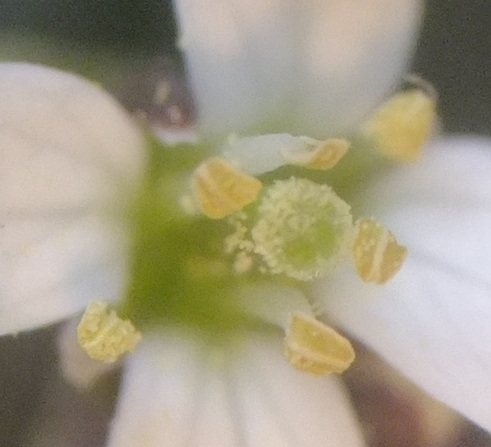
The Lesser Pond
Sedge is now flowering well with its dark brown
spikelets on the banks of the River Ems. I found the
first small clump of Distant Sedge on the
Lumley area, but still no sign at all of Divided
Sedge. A Cetti's Warbler was singing strongly
from the direction of Peter Pond.
Malcolm's
news
Malcolm
Phillips was back on Brook Meadow this morning after a
period of illness. He got several excellent sightings,
including a Water Vole just north of the sluice
gate under the tree which is across the river. No
photo, but a very welcome record. The absence of
sightings at what is usually a peak time of the year
has been quite worrying. This was out first sighting
since 28 March and only the 7th of the year.
Another excellent
sighting was the first Whitethroat of the year
on Brook Meadow - in much the same place as last year
near the north bridge.
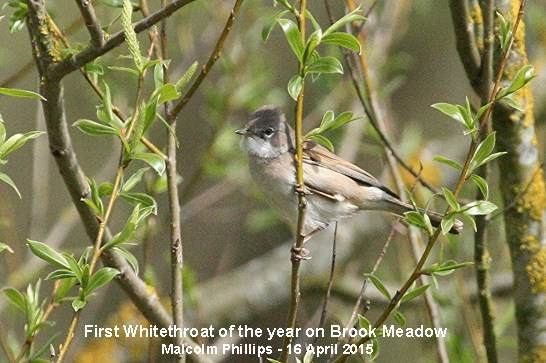
North of the bridge
Malcolm got this photo of a female Blackcap -
he says the male was also there, so perhaps a breeding
pair. These will be migrants and not wintering birds.

Malcolm also got this
image of the underwings of an Orange Tip
butterfly; both male and female have these mottled
underwings, so it could be either.

Finally, Malcolm got
this 'Nursery-web spider', of which we shall be
seeing a lot more on the meadow.
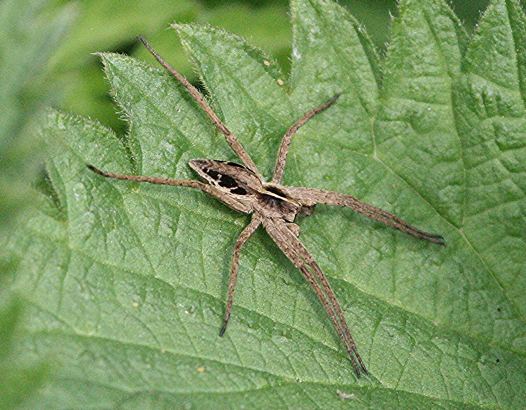
Scarce
Tortoiseshell
Jan-Paul
Charteris describes the discovery of this very rare
butterfly at the Pulborough Brooks RSPB Reserve on
April 7th. See the following link . . .
http://www.birdguides.com/webzine/article.asp?a=4961
This is what it
looks like.
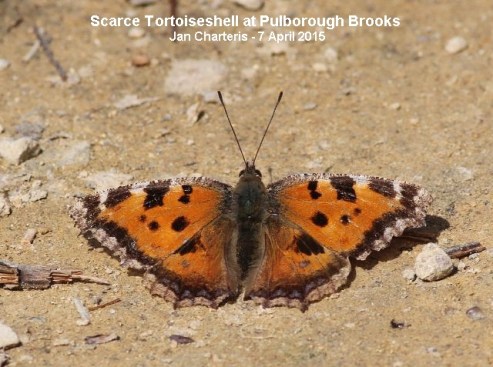
WEDNESDAY
APRIL 15 - 2015
Marlpit
Lane
09:45 - 10.15
- It was a fine sunny morning when I parked the car in
the lay-by opposite the amenity tip in Marlpit Lane
ever hopeful, as I always am at this time of the year,
of hearing my first Nightingale. I was much encouraged
by the report on the SOS sightings web site yesterday
of 7 Nightingales having been heard singing at
Pulborough Brooks. I walked slowly up and down the
lane listening for any bird song, but the only
migrants I heard were Chiffchaff, Blackcap and a
Willow Warbler, but no Nightingale. A Song Thrush gave
its poor imitation of a Nightingale.
I had a walk up the public footpath to the east where
Nightingales used to be heard in the old days, but
there was no sound of any today. There has been
further clearance of the woodland area to the north of
the site which does not auger well for the
Nightingales.
North
Thorney
10:30 - 11:15
- I parked the car at the junction of Thorney Road and
Thornham Lane and the first thing I heard when I got
out of the car was the calls of a Cuckoo coming
from the west end of the old ERA track. In fact, this
Cuckoo was calling the whole time during my walk. This
was a good start and things got better.
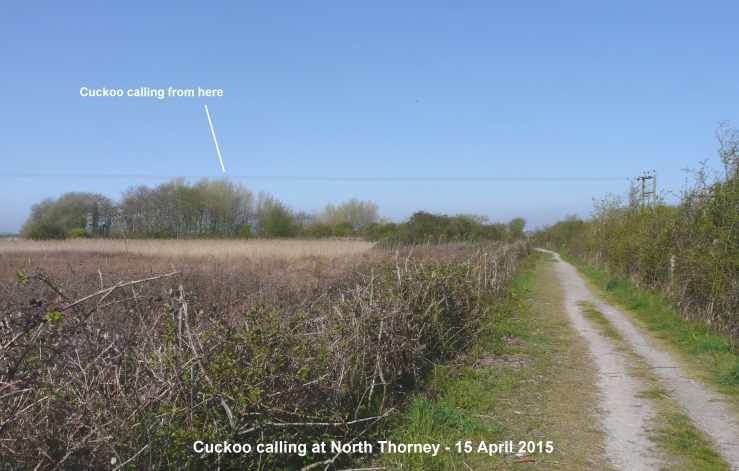
Two Swallows
were flying quite low over the track in front of me; I
assume they will be nesting in the stables to the
north as usual. 12 Canada Geese flew over,
honking noisily, heading for Emsworth Harbour.
Cetti's Warblers were singing along the track
as usual.
I turned down the
track leading to the Little Deeps and had hardly gone
any distance when I heard the distinctive rhythmic
song of a Reed Warbler. I saw it perched on
some brambles which is most un-Reed Warbler-like. I
reckon this could be the same bird that Tony Wootton
got a picture of yesterday, also on brambles.
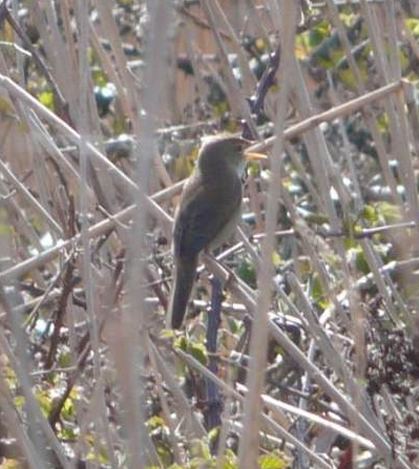
About 20 yards further
south I heard the equally distinctive song of a
Sedge Warbler; this is similar to a Reed
Warbler, but more hurried and varied with a mix of
musical phrases and harsh chattering and random
squeaky whistles. The song of the Reed Warbler in
contrast is a more rhythmic and monotonous churr,
churr, churr.
It was quite a magical experience standing there
looking out over the extensive reedbeds, with Cuckoo
to the left of me, Reed Warbler and Sedge Warbler in
front and a Cetti's Warbler to the right. All I needed
now was a Whitethroat, or a Turtle Dove, but neither
turned up.
Walking back along the old ERA track I watched two
Lapwings displaying over the grassland; maybe they
will be nesting somewhere nearby.
Langstone
Mill Pond
11:30 - 12:15
- I decided to end my little tour with a visit to this
millpond, which the regular and very detailed reports
from Peter Milinets-Raby has put firmly on the
ornithological map. The Royal Oak pub is closed for
refurbishment - due to open on May 1st so a worker
told me. The big attraction at the moment is certainly
the large number of Little Egrets in the trees
behind the pond. This photo only shows a few of them.
I actually counted 46 Egrets in the trees, though
there could well have been more. Peter Milinets-Raby
had an astonishing 72 early this morning - see Peter's
report below.

I spoke to a number of
people passing by who were curious as to what these
big white birds were doing in the trees. I explained
that this was a favoured nesting site for them.
I am not sure if
this bird is on a nest, probably not.
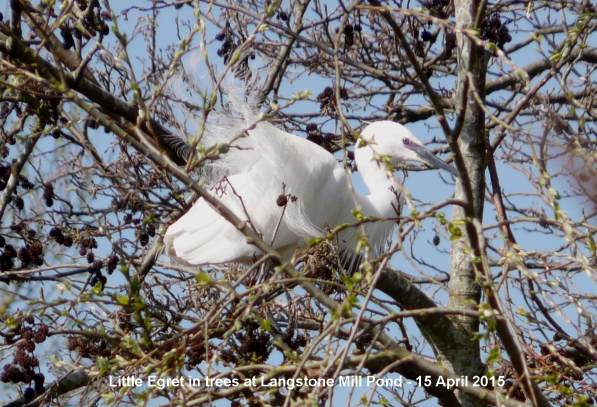
There was a good deal
of displaying going on during which the Egrets uttered
a variety of croaks and some curious gargling noises
which I do not recall having heard before. Here is
link to a YouTube video illustrating these noises:
https://www.youtube.com/watch?v=msPHBZsFK6w
I made the
acquaintance of Peter's 'friend' the cob Mute Swan,
who immediately attacked my shoe when I got a bit too
close to the edge of the pond, actually undoing a shoe
lace in the process!

Warblington
shore
Peter
Milinets-Raby said the weather early this morning was
too perfect for his little walk along the Warblington
shore (6:35am to 8:40am - tide pushing in sloooowly!).
Highlights were as follows:
2 male & a female Mallard on castle tower.
Ibis Field: 7 Med Gulls, 5 Ad summer with 2 1st
summers, 1 Little Egret, 3 Moorhen, Chiffchaff
singing. Skylark singing from big field, Male
Pheasant.
Hedgerow behind Conigar Point: 2+ Chiffchaff, Blackcap
singing, Cetti's Warbler singing and seen.
Conigar Point: A pair of Red Breasted Mergansers, 8
Shelduck, 11 Black-tailed Godwits (all in summer
plumage), 17 Bar-tailed Godwits (all in winter), 5
Whimbrel heading north and inland.
Off Pook Lane: 8 Shelduck, 2 Teal, 1 Whimbrel, 2
Sandwich Tern.
Horse paddock: (Not flooded and now not any good for
migrants or BIRDS in general AS all the hedges and
bramble bushes have been ripped out and left in the
middle to be burnt - Shocking, especially when you
consider I viewed a Redstart, Robin, Song Thrush,
Dunnock, Wren and Blackbird all in theses hedges and
bramble bushes just two days ago. And, apart from the
Redstart, all of them were probably nesting in the
hedge!!!!!! - see photo - nice view of Wade Court now
- ironic!):
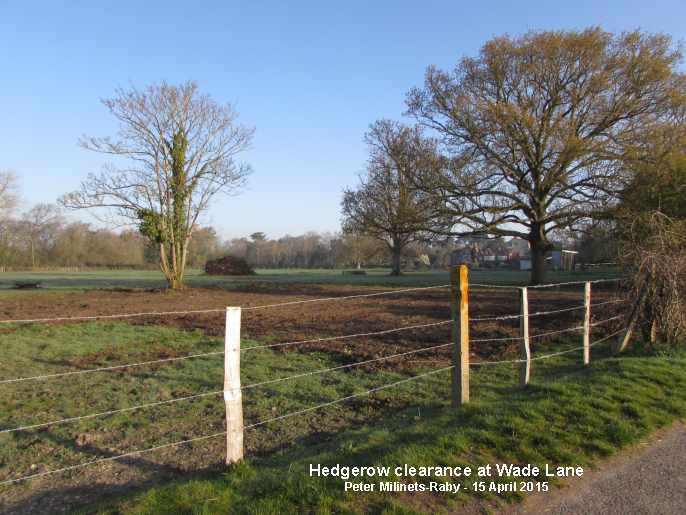
9 Moorhen, Chiffchaff
singing, 1 Swallow:
Langstone Mill Pond: 6 juvenile Grey Herons in the top
of the Holm Oak, 72 Little Egrets counted (a huge
increase on the other day), Blackcap and Chiffchaff
singing, Cetti's Warbler singing, A pair of Reed
Bunting (see photo).
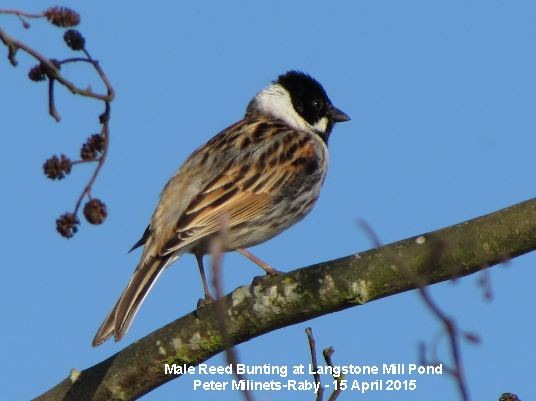
TUESDAY
APRIL 14 - 2015
North
Thorney
I
cycled/walked down to Thorney for another listen for
migrants. But no change from yesterday. No sign of
Sedge Warbler, Reed Warbler or Whitethroat. I counted
5 Cetti's Warblers singing along the old ERA track.
There was a lovely Small Tortoiseshell that I
could not resist.

Swarms
of flies
While walking
down the track to the Little Deeps I was beseiged by
swarms of flies. They did not bite even though they
were all around me.
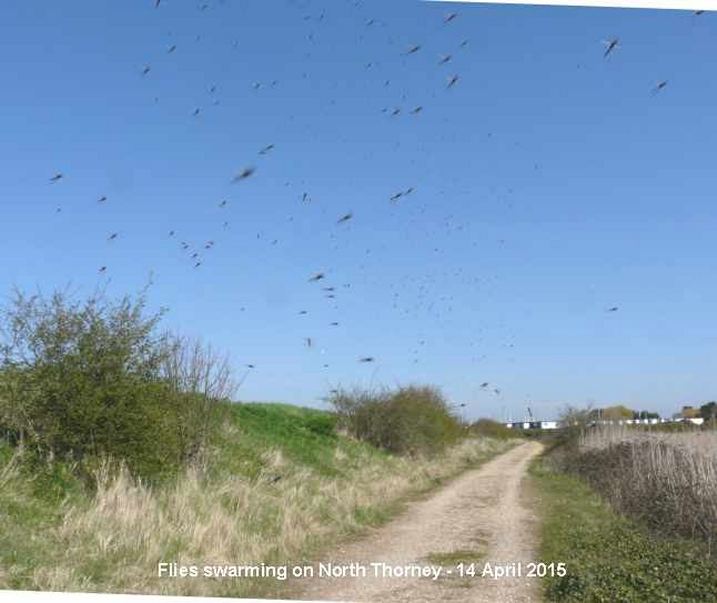
I am not sure what
they were, but they had long abdomens, feathery
antennae and held their wings over their backs at
rest.
Here is one that
came to rest on a Gorse flower.

My tentative guess is
that they were what is called 'phantom midges',
closely related to mosquitoes, but non-biting. The
larva is called a glassworm and lives in lakes, hence
the convenient proximity of the Little Deeps. From
Chinery (p.194) my best guess is Chaoborus
crystallinus, but I shall be happy to be
corrected.
Tony Wootton was also
on Thorney this afternoon and got a photo of what I am
pretty sure is a Reed Warbler. Nice one, Tony.
First of the year here, I reckon, though Peter
Milinets-Raby did have one at Warblington yesterday.

Slipper
Millpond
On the way to
Thorney I noticed that the Coot family on the north
raft on Slipper Millpond had 5 chicks not 4 that I
previously thought. There are no Great Black-backed
Gull predators this year, though they must beware of
the Herring Gulls.

There is also a Coot
nesting in the nest box on the south raft. The lone
cob swan was on the pond.
Fishbourne
Meadows
I paid a
flying visit to Fishbourne Meadows on the way home
from a trip to Chichester to check on the Divided
Sedge of which there is no sign on Brook Meadow. I
could not find any there either, so it is probably
late generally. That is a relief. I did find some
Brown Sedge and Water Horsetail the
latter in abundance. I wish we had some of this
attractive plant on Brook Meadow. Brown Sedge is on
the left and Water Horsetail on the right.
I noted that the river
had been fenced since I was last here, presumably to
keep out dogs and protect the Water Voles. Good
policy. We have used dead wood fencing on Brook
Meadow.
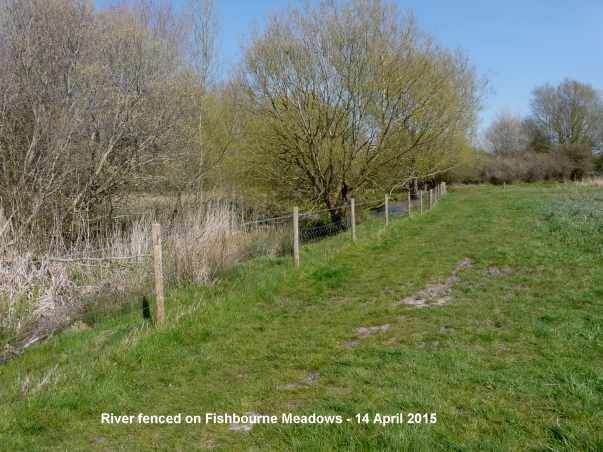
For
earlier observations go to . . April
1-13